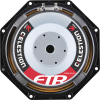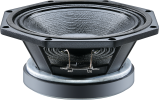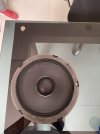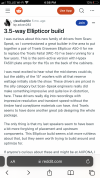What an intriguing thread! Took most of my morning here in India reading this thread almost completely and am now tempted to put in my version of end game speakers I have been listening to for a couple of months now. This took me several months of iterations experimenting with 12 and 15 inches woofers/subwoofers, and then later with 10 inches for a reasonable sized room with some padding and diffusers with but a glass wall and a bookshelf, etc, I just could not come close to building a satisfactory system, till this one happened (happened is perhaps the right word- you mix and match and build and rebuild, and one fine day you stumble upon magic).
Synopsis: An Active 4 way stereo system which could be used for music as also casual home cinema speakers duty. Now before you judge me and say an immersive cinema experience can only be had with dedicated surrounds, centre, and satellites, etc., please understand the idea was to install it in a small to medium sized room with a couple of lounging chairs and a book shelf plus a large screen television to be used as a den without carrying the whistles of a full fledged home theatre. There would be reasonable wall paddings and diffusers installed at places, would not be a completely dark room (need regular reflections of light for a relaxing environment), not completely cut off from the main living areas. Which means sound would reflect somewhat and it will not be an acoustic room. This would of course present its difficulties in tuning the system and ensuring the coloration is manageable with minimum phase/timing corrections.
Wife acceptance factor: This could never be a winner in this department but still had to be of a reasonable footprint to not be completely out of place in room sizes 200 square feet or more.
The costs: To be kept under $ 5k (of course ignoring man hours gone incognito into iterations).
Driver selection:
Sub bass: 4*8” subwoofers used each side and driven at relatively high wattage and equalised so that the extra radiating area would compensate for low efficiency and a fairly decent fs in the low forties with a port tuned to below 30 hz would cover the entire spectrum from below 30 to upto 200 hz. For new recordings either digitally produced or with lots of instruments, this would be a low pass at around 80/100 hz, and for old recordings with nothing below 40 hz to hear and vocals between 80-200 hz requiring a higher thrust, the low pass would be placed higher between 140-200 hz.
Bass/Mid bass: Frequencies up to 700hz- Celestion 8 inches FTR-08- 2011D pro driver. These show an extremely flat response from 100 hz- 3000 hz in a sealed box based and was perfect for the job. I only needed it to play between 100-700 hz and these do wonderful duty in this range. I have used these extensively between 70-5k hz and they have become my favourite mid drivers. The depth in the vocals is extremely pleasing with these drivers.
Tweeter: A Peerless Tymphany D27TG35-01 1” silk tweeter has always been my favourite, partly because these are easily available in India, and are the most forgiving with below par crossovers and are at home equalised anywhere from 2.2 khz and above.
Mid range: I had a variety of speakers to do duty between 700 hz to 2.3/3.3khz and chose a well built pro inexpensive 8” driver with a low xmas owing to a stiff surround but a very light wool mixed composite paper cone (both the subwoofer drivers and mid range drivers were sourced from a local manufacturer in Delhi). The alternative was the Celestion TFO510 (I have an affinity towards Celestion pro drivers) and either of these worked very well, with some listeners gravitating towards the Celestion and some including me over the 8 inch driver.
The cabinets: Two cabinets were built with similar width to keep on top of each other, for a homogenous radiating area. Both were built in two layers using 19mm medium density fibre board, and diffusers made of same material and wool felt lining the walls inside. The diffusers were cut into curved small pieces to somehow make the cabinets believe they were not rectangular, to try to fool the standing waves not to color the music to unacceptable levels. The subwoofer cabinets have bracing lined up on the corners and between each driver, and measure 13.25”*18.75”*47.25” to achieve slightly less than 4 cubic feet internal volume overall, and further lined with polyfil with 0.25 inches layers one at a time to assess the optimum fill levels, which was arrived at 3 layers eventually. Two ports of 3.5 inches clear diameter with minimal flairs and 8.5” long are used at the bottom and tuned to 29 hz.
Each driver has its own 1” baffle grinded into a slope to meet the edge of the membrane. Below which the drivers are surface mounted. This has somewhat met the criteria of lower baffle excitement on account of the large overall radiating area of 4 woofers together. The edges are rounded and perhaps serve a cosmetic purpose rather than any real diffusion.
The rest of the 3 way cabinet measures 13.25”*14.75”*23.75” and the midrange and the tweeter are in a separate enclosure within this enclosure. Though perhaps such a large cabinet was not needed since the Celestion mid woofer has a very low qts and requires but a small chamber sealed, the placement of the 3 speakers with internal partitions was not possible without this front profile. Measurement of this 3 way was taken separately both in an almost acoustically dead room and outside, and was found to be fairly flat from 100 hz above, at which frequency it is to be really used.
Crossover: Two units of DBX 234XL each used mono 4 Way, with the general cut off points at 100hz, 700hz and 3.3khz. Being active a variety of slopes can be played around for each driver, which really gives a large latitude in arriving at a listener’s sweet spot according to the genre of music playing.
The media- A smart TV, a receiver, a dvd player, anything which has a pre-out.
The amplifiers: 8 channels of analogue class AB classic amplifier designs of no more than 3 stages with limited feedback custom assembled for these speakers. They are 600, 200, 200 and 100 watts each side, all with a Toshiba 5200/1943 topology.
Finish: These are finished in a high gloss veneer, and automotive black paint, and if you will pardon the smudges of dirty hands here and there, they are quite pleasing to look at too. The baffle on the top has been taken off in this unit. In another unit you can see the baffle on with the midrange being played by a carbon mixed membrane 6" mid woofer.
The verdict: And there we have. I am blessed to have a couple of golden eared people who have auditioned these, not to mention a few audiophile friends, and a couple of hi-fi store owners, several other casual listeners and we have all found these extremely musical. Some including me have been so emotionally moved of the purity and resolution of music coming out of these speakers, that we find it difficult to move away once we have listened for an hour. The subwoofers are capable of producing quite deep rumbling notes in motion soundtracks, and the music otherwise appears very complete with no jarring notes. These are speakers perhaps of which I will not grow out of for a long time.
Are these end game? For several listeners these are, for the time being, in this size of a room and its setting, till I am able to make something better.

















